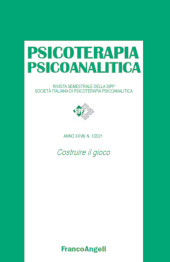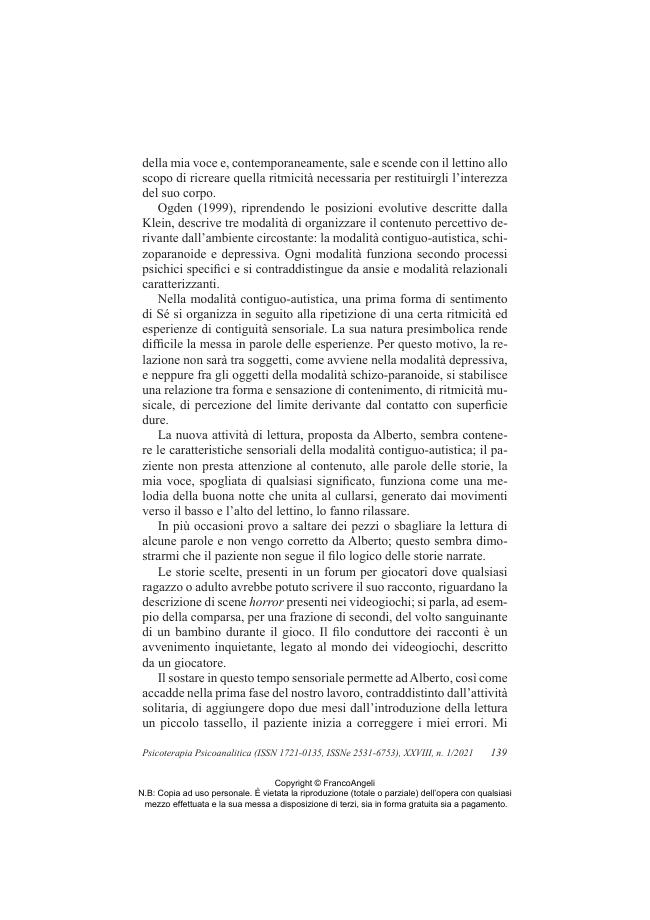Costruire il gioco con un paziente autistico
134-144 p.
L'autore descrive un caso clinico di un adolescente autistico seguito in un centro di riabilitazione. Il funzionamento psichico del paziente non permette di giocare con il suo analista perché mancano la capacità simbolica e l'incontro relazionale in uno spazio potenziale. Per il paziente la relazione è vissuta come pericolosa, evitata e tenuta a distanza attraverso l'esercizio di un marcato controllo. Inizialmente il paziente è impegnato in un'attività solitaria che ha una doppia funzione: di autodifesa e di autocostruzione, necessarie per la propria sopravvivenza. Il sostegno silenzioso dell'analista permette il passaggio a una prima apertura relazionale, la condivisione di storie. Le storie hanno dapprima un carattere sensoriale, contraddistinto dal suono della voce e il dondolio del lettino, per iniziare ad acquisire un senso.
La continuità e ritmicità sensoriale creano le basi per una prima forma di continuità dell'essere, il paziente inizia a riconoscere la presenza dell'oggetto e questa apertura crea le condizioni per la definizione di un'attività sempre più condivisa, dove l'esclusività del carattere sensoriale si indebolisce ed è possibile rintracciare i prodromi di significati più articolari. Il lavoro analitico è stato contraddistinto dalla costruzione dei rudimenti psichici, dalla definizione dei confini mentali e dalla tolleranza della vitalità relazionale, per poter iniziare a giocare con i propri pensieri. Si delinea sempre più il passaggio da un'attività solitaria e sensoriale al poter giocare "insieme". [Testo dell'editore].
The author describes a case report of an autistic teenager being treated in a rehabilitation center. The psychic functioning of the patient does not allow to play with his analyst because the symbolic capacity and the relationship in a potential space are lacking. For the patient, the relationship is experienced as dangerous, avoided and kept away with the use of great control. At the first time, the patient is engaged in a solitary activity that has a double function: selfdefense and selfconstruction, necessary for his own survival. The analyst's silent support allows the passage to a first relational opening, the sharing of stories. The stories first have a sensorial character, characterized by the sound of the voice and the rocking of the bed, to begin to acquire a sense.
Sensory continuity and rhythmicity create the basis for a first form of continuity of being, the patient begins to recognize the presence of the object and this opening creates the conditions for the definition of an increasingly shared activity, where the exclusivity of the sensory character weakens and it is possible to trace the prodrome of more articular meanings. The analytic work was characterized by the construction of psychic rudiments, the definition of mental boundaries and the tolerance of relational vitality, in order to start playing with one's thoughts. The transition from a solitary and sensorial activity to being able to play "together" is becoming more and more evident. [Publisher's text].
Ist Teil von
Psicoterapia psicoanalitica : 1, 2021-
Artikel aus derselben Ausgabe (einzeln erhältlich)
-
Informationen
ISSN: 2531-6753
KEYWORDS
- Autismo, adolescente, gioco, attività, costruzione, condivisione
- Autism, teenager, play, activity, building, sharing



